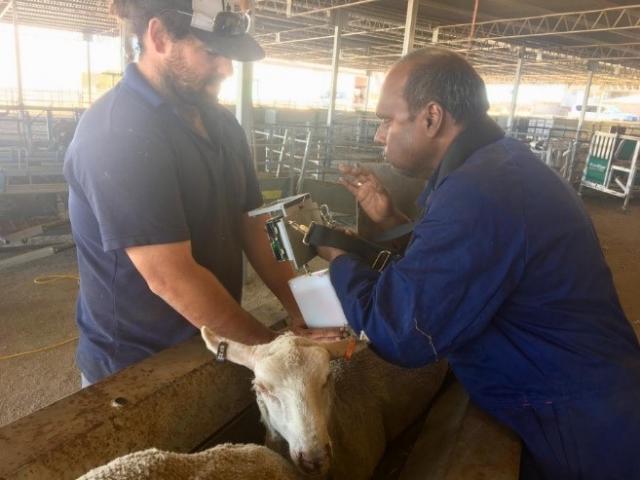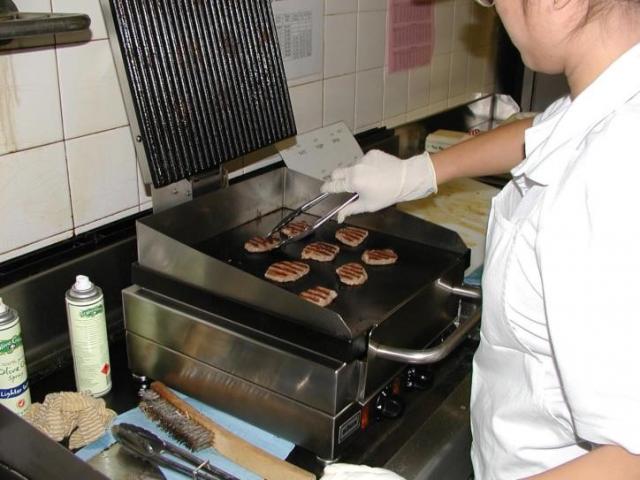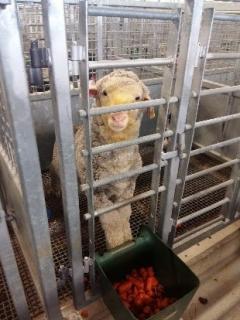Measuring the fat depth of lambs with microwave technology
Jayaseelan Marimuthu, Murdoch University, WA
Author correspondence: jayaseelan.marimuthu@murdoch.edu.au
This project was funded by the Advanced Livestock Measurement Technologies project. This is the second of a two part report on the use of non-invasive microwave to measure fat depth in lambs. Part one reported the technique on lamb carcasses and was published in the January 2020 edition of the Ovine Observer.
Introduction
Finishing lambs with optimal fat coverage is important for producers to maximise production efficiency. Animals sent to slaughter that are graded too lean or overly fat will be heavily penalised by processors, as overly lean carcases will not meet retail cut specifications while overly fat carcases require extra trimming and represent waste. Overly fat carcases also represent wasted resources spent feeding that animal prior to slaughter.
The fat depth of live sheep can be estimated by manually condition scoring animals or by ultrasound assessment, however these methods are relatively subjective, time-consuming and costly.
The Australian Livestock Measurement Technologies project (ALMTech) is investigating technologies such as microwave that could improve the objective measurement of important traits such as fat depth in livestock and carcasses.
One technology showing considerable promise for measuring carcase fatness is a Microwave System (MiS) that uses low power non-ionizing electromagnetic waves to measure carcase fat depth. The successful capacity of a portable prototype MiS system to estimate fat depth at the C-site in lamb carcasses (measured 5cm from the midline over the 12th rib in lamb carcasses) was detailed in a January 2020 article of the Ovine Observer.
The MiS system can accurately evaluate the fat depth of carcases due to the different dielectic properties of body tissues including skin, fat, muscle and bone. The MiS system therefore also demonstrates potential to quickly, accurately and safely measure fat depth in live sheep. A low-cost portable handheld microwave system has been developed to assess its ability to predict ultrasound C-site fat depth and eye muscle depth in lambs.
Materials and methods
Lambs (n=800) were selected from the MLA Resource Flock hosted by DPIRD in Katanning Western Australia for this experiment. The lambs were of mixed sex and breed type; the progeny of Terminal, Merino and Maternal sire types, crossed with Merino and Maternal dams. All lambs were weighed before being scanned in a race at the C-site using an ultrasound scanner and the prototype microwave system to measure C-site fat depth and eye muscle depth.
The ultrasound scanning of the C-site was performed by an experienced operator. The prototype microwave system used a Vivaldi-patch antenna (VPA) and operated at frequencies of 100 MHz to 5.4 GHz (increasing in 10MHz steps and thus generating 531 distinct frequencies – i.e. 100 MHz, 110 MHz, 120 MHz,…5400 MHz) with an output power of -30 dBm (0.001 milliwatt).
At this low power output the microwave measurement will not cause any damage to nor even be noticed by the animal. Lambs were immobilised in a race, the wool parted at the C-site and the VPA antenna was placed along the skin for scanning, to minimise the impact of wool on the microwave signal.
Microwave signals were then used to predict the ultrasound C-site fat depth and eye muscle depth using a range of machine-learning modelling methods including Support Vector Regression, Random Forest, and an Ensemble Stacking technique that combined both the Support Vector Regression, Random Forest and Partial Least Squares regression methods. All methods were trained using a 10-fold cross validation procedure, with R-square (R2) and root mean square error (RMSE) demonstrating the prediction precision (see Table 1).
R2 is a measure of the variation explained by the prediction model, with 1 being a perfect prediction, and RMSE is a measure of the error in the prediction model, with a smaller RMSE indicating the prediction based on the microwave C-site fat depth is close to the actual fat depth. The procedure was repeated with the inclusion of live weight in the predictive model (see Table 2).
Results and discussion
The lambs in the study demonstrated a wide range in live weight of 21 to 68kg; in ultrasound C-site fatness of 1 to 7.6mm and eye muscle depth of 9 to 34mm.
Microwave signals from the prototype hand-held device were able to predict ultrasound C-site fat depth measures with low to moderate precision and eye muscle depth with low precision. The Ensemble stacking method produced the best prediction of fat depth with R2 = 0.42 and RMSE = 0.736, and could provide a slightly more precise prediction of eye muscle depth (R2 = 0.27 RMSE = 3.685) than the Random forest method (Table 1, Figure 1).
Precision before accounting for live weight
|
| C-site Fat Depth | C-site Eye Muscle Depth | ||
|---|---|---|---|---|
| Modelling method | R2 | RMSE | R2 | RMSE |
| Partial least square regression (2 components) | 0.18 | 0.87 | 0.12 | 4.06 |
| Support vector regression | 0.36 | 0.78 | 0.22 | 3.81 |
| Random forest | 0.38 | 0.76 | 0.27 | 3.69 |
| Ensemble stacking | 0.42 | 0.74 | 0.27 | 3.68 |
RMSE = Root mean squared error; R2= R-square
Precision after accounting for live weight
| Modelling method (live weight included) | C-site Fat Depth | C-site Eye Muscle Depth | ||
|---|---|---|---|---|
| R2 | RMSE | R2 | RMSE | |
| Partial Least square regression (2 components) | 0.55 | 0.65 | 0.69 | 2.40 |
| Support vector regression | 0.58 | 0.63 | 0.70 | 2.38 |
| Random forest | 0.43 | 0.73 | 0.39 | 3.42 |
| Ensemble stacking | 0.61 | 0.60 | 0.70 | 2.35 |
RMSE = Root mean squared error; R2= R-square
The precision of microwave prediction of ultrasound C-site fat depth improved markedly when lamb live weight measures were included in the models (Table 2), with Ensemble stacking modelling of microwave data able to predict ultrasound fat depth with an R2 = 0.61 and RMSE = 0.604 (Table 2, Figure 2). Inclusion of lamb live weight in the modelling also substantially improved the ability of the Microwave scanner to predict ultrasound C-site eye muscle area, with an R2 = 0.70 and RMSE = 2.352 with the Ensemble stacking modelling.
Conclusion
These results demonstrate that the prototype handheld microwave scanner is capable of measuring C-site fat depth and eye muscle area with moderate precision, similar to the precision achieved for the prediction of C-site fat depth in carcasses reported in the January 2020 edition of the Ovine Observer. Of the different statistical methods tested the Ensemble stacking technique consistently produced the most precise predictions. This algorithm will be easily deployed within handheld microwave units to rapidly deliver fat depth predictions when measuring live animals in remote settings.
The microwave system predicted C-site fat depth with better precision than eye muscle depth, however the inclusion of live weight data improved eye muscle depth prediction to a greater extent than fat depth. This likely reflects the greater correlation between live weight and muscling or eye muscle depth compared to fat depth. Regardless, these greatly improved precision estimates demonstrate that the simultaneous use of a set of scales with a handheld microwave scanner can provide a quick and relatively precise estimate of C-site fat depth.
Small issues arose with microwave scanning in this experiment. This includes the technician’s fingers being too close to the microwave antennae when parting the wool for measurement, which is likely to have influenced the reflection of microwave signals. Additionally, the placement of the microwave antenna on the same location as the ultrasound scanning meant that some oil remained on the skin and may have influences the microwave measurements. Measures may be improved if the microwave antenna were placed parallel to the midline of the animals. These factors will be improved or investigated in further testing of the prototype scanner and may further improve the precision with which the system can predict fat and eye muscle depth.
The microwave system could be easily, safely and quickly used by untrained personnel to produce an objective measure of back fat in livestock that may help inform producers on when their stock are in optimal condition for slaughter.
American, Chinese and Australian consumers are on the same page when scoring lamb eating quality
Rachel O’Reilly, Murdoch University, WA
Author correspondence: R.OReilly@murdoch.edu.au
Introduction
Untrained consumers are commonly used to measure the eating quality (EQ) of lamb and sheepmeat. Consumer tasting sessions of Australian lamb meat following Meats Standards Australia (MSA) protocols are undertaken domestically and overseas to understand consumer preferences in different markets and to determine the EQ of meat produced from different animals. To confidently use the EQ scores given to lamb meat by untrained consumers, it is important to understand whether consumer demographic factors such as appreciation of lamb meat or preferred cooking doneness differ substantially between countries and influence consumer lamb EQ scores.
Previous work using Meat Standards Australia (MSA) protocols has shown that consumers with a greater appreciation of meat will score EQ more favourably compared to those indifferent to red meat. This was the case for both sheep meat and beef, although increases were small and not consistent in all countries assessed (Australia, France, Northern Ireland, Poland). In addition, consumers who prefer a higher degree of cooking doneness tend to score EQ higher than those with a preference for medium doneness (Australia, Northern Ireland, and Ireland). In contrast, untrained consumer testing of grilled Australian beef in Korea demonstrated that Korean consumer EQ scores were not influenced by red meat consumption preferences.
China and America are important export markets for Australian lamb and have therefore been targeted for tasting sessions to understand the consumers within these markets. However, the influence of Chinese and American consumer demographics on their EQ scores of lamb is unknown. Given the similarities between Chinese and Korean traditional cuisines, it is likely that Chinese consumer EQ scores may be less responsive to consumer meat appreciation or cooking doneness preferences compared to American and Australian consumers.
General aims
This study aims to assess how consumer preferences for meat appreciation and cooking doneness in Chinese, American and Australian consumers influence their EQ scoring of Australian lamb meat. We hypothesise that Chinese consumers’ EQ scores will be less responsive to differences in consumer preferences than American or Australian consumers.
Results
Contrary to expectations, the effect of consumer preferences for lamb appreciation and cooking doneness on lamb EQ scores did not differ between China, Australia and the USA.
The frequency of lamb consumption differed between the three countries, with Australians and Chinese commonly consuming lamb weekly to monthly while American consumers rarely consumed lamb (Figure 3).
However, the impact of lamb consumption frequency on EQ scores did not differ between countries (P > 0.05).
The importance of lamb in the diet of consumers also differed between countries, with the majority of Australians valuing lamb as an important part of their diet, while the majority of Chinese were indifferent to lamb in their diet and Americans rarely to never eat lamb (Figure 4). However, the impact of consumer lamb appreciation on EQ scores did not differ between the countries.
High consumer appreciation of lamb in the diet improved flavour scores by 2.9 to 3.9 units compared with scores from consumers who rarely or never eat lamb, respectively (P < 0.05). However, contrary to expectations high consumer appreciation of lamb did not improve scores for tenderness, juiciness or overall liking (P > 0.05).
Consumer preference for cooking doneness differed between countries, with Australian and Americans preferring medium rare to medium well done while Chinese consumers almost all preferred well done lamb meat (Figure 5). However, the impact of consumer preference for cooking doneness on EQ scores did not differ between counties; influencing the average juiciness scores (P<0.05), but not influencing consumer scores for tenderness, flavour or overall liking.
In line with previous research, consumers who preferred their meat cooked medium-rare scored samples 2.6 and 3.4 units lower on average than those preferring medium-well or well-done lamb meat.
Discussion
Consumer preferences for lamb meat did differ substantially between Australian, Chinese and American consumers, however this had little or no impact on EQ scores which did not differ between countries.
Lamb meat appreciation influenced flavour scores and preference for doneness influenced juiciness scores, however consumer preferences did not consistently influence the different EQ traits and therefore overall have negligible impact on lamb EQ scoring.
These results demonstrate that balancing for consumer demographics is not necessary in studies using MSA protocols, as meat consumption preferences have minimal impact on eating quality scores of lamb for American, Chinese and Australian consumers.
Feeding unsalable carrots in total-mixed rations for lambs
Daniel Forwood (UQ), Louwrens Hoffman (UQ), Alex Chaves (USYD) and Sarah Meale (UQ)
Author correspondence: d.forwood@uq.edu.au
Introduction
Food waste is estimated to cost Australians $20 billion per year. Vegetables comprise approximately 29% of total food wastage, with one-third of carrots produced in Australia being discarded due to aesthetic standards set by industry.
Fresh carrots are an energy-dense feedstuff comprising approximately 13.76 MJ metabolisable energy/kg dry matter and 10% crude protein. Therefore, an opportunity exists to use carrots that do not meet industry aesthetic standards in livestock rations.
However, fresh carrots have not previously been fed to ruminants as a total-mixed ration (TMR). Therefore, the impact of including carrots in a lamb TMR on lamb performance, carcass and meat quality is not known. Carrot total mixed ration
The objective of this study was to determine the influence of a TMR including unsalable carrots on lamb performance as measured through live weight gain, carcass characteristics including hot carcass weight, subcutaneous fat depth, and meat quality attributes including meat and fat colour. It was hypothesised that feeding carrots in a TMR would have no effect on these traits.
Materials and methods
Thirty-six 7-month old Merino wether lambs were randomly allocated to one of two diet groups- control or carrot TMR, with both groups balanced by live weight (24.7±0.3 kg LW). The lambs used in this study were cared for under the approval and guidance of The University of Queensland Animal Ethics Committee (AE59549), in accordance with the Animal Care and Protection Act (2001). The dry matter (DM) composition, predicted metabolisable energy and protein content of each TMR are shown in Table 3.
|
| Total Mixed Ration | |
|---|---|---|
|
| Control | Carrot |
| Barley grain | 50.2 | 8.7 |
| Fresh carrot | - | 45.9 |
| Lucerne hay | 42.0 | 30.0 |
| Canola meal | 7.2 | 15.2 |
| Mineral supplement | 0.6 | 0.2 |
| Predicted metobolisable energy (MJkg DM)* | 10.4 | 10.7 |
| Predicted crude protein (g/kg DMI)* | 151 | 150 |
*Predicted values determined using the Small Ruminant Nutrition System (Texas A&M University)
Lambs were individually-housed for the feeding experiment to capture individual feed intake (g DM intake per day). The lambs were adapted to their allocated diet for 14 days before being fed this same diet ad libitum for an experimental period of 11 weeks leading up to slaughter. Lamb live weights were obtained weekly prior to feeding.
At 10-months of age, lambs were slaughtered at a commercial abattoir. Hot and cold carcass weight were measured on each lamb. Subcutaneous fat depth, eye muscle area and meat quality attributes were measured on the chilled loin muscle (Longissimus dorsi et thoracis) 24 hours post mortem and included ultimate pH, meat colour, fat colour, Warner-Bratzler shear force, drip loss and cooking loss. Meat and fat colour were measured using a Konica Minolta CR-400 Chromameter with a standard xenon lamp at 8 mm aperture. The experimental data was analysed using a mixed procedure in SAS, with diet included as a fixed effect and animal within diet as a random effect. Lamb was considered the experimental unit.
Results and discussion
Lamb performance
Lambs fed the Carrot TMR had a final live weight 1.7 kg greater than lambs on the Control TMR (40.5 vs 38.8 kg; P = 0.02). This indicates that the lambs fed carrots in their TMR demonstrated slightly better growth performance than lambs on the control TMR. Dry matter intake of lambs was 9.3% higher for lambs fed the Control TMR (951 vs. 870 g; P < 0.01). Further, lambs fed the Carrot TMR had 22% greater average daily gain than lambs fed the Control TMR (Figure 6; P < 0.01).
Carrot-fed lambs had better feed conversion efficiency, requiring 4.70 kg of feed (DM) for 1 kg of live weight gain compared to the 6.34 kg DM of the Control TMR per kg of live weight gain (i.e., required 26% less feed to achieve the same weight gain; Figure 7; P < 0.01). These results suggest that unsalable carrots are a suitable substitute for barley grain in lamb TMRs to improve production efficiency.
Carcass traits
The improved production efficiency of lambs fed carrots in their TMR resulted in 1.7kg heavier hot and cold carcass weights following slaughter (P < 0.01) and an improved dressing percentage (P = 0.03). However, the diet did not influence the composition of the carcass, with no difference in muscling (eye muscle area) or fat depth between the TMR (Table 4; P ≥ 0.41).
| Carcass trait | Control | Carrot | SEM | P-value |
|---|---|---|---|---|
| Hot carcass standard weight (kg) | 16.2 | 17.9 | 0.27 | < 0.01 |
| Cold carcass standard weight (kg) | 15.8 | 17.5 | 0.26 | < 0.01 |
| Cold dressing percentage (%) | 40.8 | 43.5 | 0.84 | 0.03 |
| Eye muscle area (cm2) | 11.6 | 11.6 | 0.47 | 0.97 |
| Subcutaneous fat depth (mm) | 4.20 | 3.76 | 0.37 | 0.41 |
SEM: Standard error of mean
Meat quality
In line with our hypothesis, inclusion of unsalable carrots in the TMR did not influence meat quality parameters. The diet did not influence the ultimate pH of the carcass (P = 0.66; Table 5) and there was no difference in meat tenderness between the different TMRs as measured by Warner-Bratzler shear force (P = 0.77). Similarly, no difference was found in drip loss, cooking loss, meat colour or fat colour (P ≥ 0.08).
| Meat quality trait | Control | Carrot | SEM | P-value |
|---|---|---|---|---|
| Ultimate pH | 5.61 | 5.62 | 0.02 | 0.66 |
| Meat colour |
|
|
|
|
| Redness (a*) | 16.3 | 16.3 | 0.32 | 0.97 |
| Yellowness (b*) | 6.97 | 6.77 | 0.19 | 0.47 |
| Fat colour |
|
|
|
|
| Redness (a*) | 9.33 | 10.1 | 0.31 | 0.08 |
| Yellowness (b*) | 62.0 | 63.4 | 1.25 | 0.44 |
| Warner-Bratzler shear force (N) | 43.1 | 43.9 | 2.10 | 0.77 |
| Drip loss (%) | 1.24 | 1.25 | 0.06 | 0.96 |
| Cook loss (%) | 20.6 | 21.8 | 1.40 | 0.57 |
SEM: Standard error of mean
Conclusion
The results of this study suggest that inclusion of unsalable carrots at up to 46% DM in a TMR can improve the efficiency of lamb meat production, without negatively influencing carcass and physical meat quality attributes.
The authors would like to thank Meat & Livestock Australia for their financial support of Daniel Forwood.






